San juan capital city: San Juan, Puerto Rico
Discover Our Shared Heritage Travel Itinerary | ||||||||||||
|
Old San Juan Historic District San Juan, Puerto Rico
| ||||||||||||
San Juan, Puerto Rico, is the oldest continuously inhabited post-European contact city in United States territory and the second oldest in the entire Western Hemisphere. Old San Juan’s historic architecture reflects four centuries of development that shaped the historic urban landscape. Today, it is the nation’s most complete Spanish urban center with its Gothic, Renaissance, and Baroque architecture. These styles of architecture create a sense of drama and authority with their beautifully-detailed ornamentation, arches, and domes. Old San Juan’s impressive fortifications include La Fortaleza, the three forts of San Felipe del Morro, San Cristóbal and San Juan de la Cruz (El Cañuelo), and a large portion of the city wall, constructed between the 16th and 19th centuries to protect the city and the Bay of San Juan. The Conquest Period (1525-1625)
Spanish explorer Juan Ponce de León founded San Juan in 1519. On del Cristo Street, the capital’s first cathedral, La Catedral de San Juan Bautista, is still open daily for services. The colonists included a public plaza used for open-air markets and social exchange, called Plaza de la Catedral, just outside the church. Plazas were common in Spanish cities in Europe at the time. Shortly thereafter, noting its small size and steep terrain, the community created another plaza, the Plaza de Armas, further inland at Calle de San Francisco to provide a more functional social center. Today, Puerto Ricans consider the Plaza de Armas the heart of Old San Juan. Adjacent to La Catedral de San Juan Bautista and built on the site of Ponce de León’s own home by his son-in-law, Casa-Torre de Ponce de León dates from the 16th century and served as both a shelter and a fort for the family’s defense. Although Ponce de León never lived in Casa-Torre, generations of his descendents did. To protect the capital from attack, the colonists built forts and military defenses. These defenses form one of the most iconic images of Old San Juan today: a city ringed with stone. The stone fortification walls constructed over 250 years eventually met to unite two of the city’s largest forts, Castillo de San Felipe del Morro and Castillo de San Cristóbal that are part of San Juan National Historic Site. The forts protected San Juan from sea and land-based attacks. Growth during the 18th and 19th centuries In the 18th and 19th centuries, Old San Juan entered an era of relative tranquility and sustained growth. New trends in architecture, including dramatic Baroque designs, crossed the Atlantic reaching San Juan by the 18th century infusing new architectural traditions into the city’s built environment. Some of San Juan’s most impressive extant buildings remain from this period — both imposing public architecture and 18th-century homes.
Two Baroque buildings, Palacio Episcopal and Palacio Rojo, occupy prominent locations within the urban landscape. The Modern Period (1812-1898) Originally constructed in the 16th century, the Spanish fort La Fortaleza, also known as the Palacio de Santa Catalina, at 63 Calle de la Fortaleza was an early defensive fortification for the city. It still has its two round towers and a crenellation-topped wall that connects them. A large Renaissance Revival palace wing with an impressive neo-Renaissance façade was added in the mid-19th century. Luxurious rooms in its interior contribute to its palatial appearance. Palacio de Santa Catalina has been the home of the governors or capitanes-generales since the 1500s and is the oldest executive mansion still in use today in the Western Hemisphere. Significant and handsome domestic buildings in the district from this period display detailed ornamentation and classical-revival influence in the forms of Renaissance Revival, Arab Revival, and Second Empire styles of architecture.
Also worth seeing is the Cementerio Santa María Magdalena de Pazzis. This cemetery, started in 1841, reflects both mixing of architectural styles and new ideas about society. Residents built it outside the city walls because they wanted to separate the dead from the living population. This represents an important transition in ideas about public health and hygiene. The cemetery is also an example of the diversity of architectural influences on San Juan. The cemetery has a Renaissance Revival chapel and dozens of funerary sculptures in Neo-Gothic and Victorian designs. The cemetery is still in use and can be explored to locate graves of Puerto Rico’s prominent residents.
| ||||||||||||
|
| ||||||||||||
NPS Home – Site Index | NPS Frequently Asked Questions | Contact NPS | Disclaimer | Accessibility | ||||||||||||
San Juan,Puerto Rico
Excerpts from Wikipedia, the free encyclopedia
San Juan (/ˌsæn ˈhwɑːn/; Spanish pronunciation: [saŋ ˈxwan], Saint John) is the capital and most populous municipality in the Commonwealth of Puerto Rico, an unincorporated territory of the United States.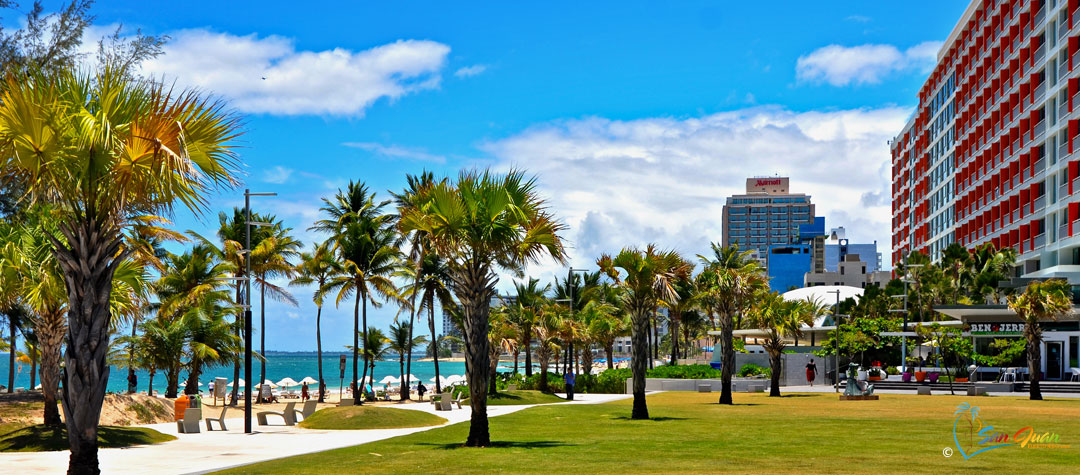 As of the 2010 census, it had a population of 395,326 making it the 46th-largest city under the jurisdiction of the United States. San Juan was founded by Spanish colonists in 1521, who called it Ciudad de Puerto Rico (“Rich Port City”). Puerto Rico’s capital is the second oldest European-established capital city in the Americas, after Santo Domingo, in the Dominican Republic. Several historical buildings are located in San Juan; among the most notable are the city’s former defensive forts, Fort San Felipe del Morro and Fort San Cristóbal, and La Fortaleza, the oldest executive mansion in continuous use in the Americas.
As of the 2010 census, it had a population of 395,326 making it the 46th-largest city under the jurisdiction of the United States. San Juan was founded by Spanish colonists in 1521, who called it Ciudad de Puerto Rico (“Rich Port City”). Puerto Rico’s capital is the second oldest European-established capital city in the Americas, after Santo Domingo, in the Dominican Republic. Several historical buildings are located in San Juan; among the most notable are the city’s former defensive forts, Fort San Felipe del Morro and Fort San Cristóbal, and La Fortaleza, the oldest executive mansion in continuous use in the Americas.
History
In 1508, Juan Ponce de León founded the original settlement which he called Caparra. It was named after the Province of Caceres in Spain, the birthplace of Nicolás de Ovando, then the Governor of Spain’s Caribbean territories, today it is part of the Pueblo Viejo sector of Guaynabo, just to the west of the present San Juan metropolitan area. A year later, the settlement was moved to a site then called Puerto Rico, Spanish for “rich port” or “good port”, after its similar geographical features to the town of Puerto Rico of Gran Canaria in the Canary Islands. In 1521, the newer settlement was given its formal name, Puerto Rico de San Juan Bautista.
A year later, the settlement was moved to a site then called Puerto Rico, Spanish for “rich port” or “good port”, after its similar geographical features to the town of Puerto Rico of Gran Canaria in the Canary Islands. In 1521, the newer settlement was given its formal name, Puerto Rico de San Juan Bautista.
The ambiguous use of San Juan Bautista and Puerto Rico for both the city and the island in time led to a reversal in practical use by most inhabitants: by 1746 the name for the city (Puerto Rico) had become that of the entire island, leading to the city being identified as Puerto Rico de Puerto Rico on maps of the era. On the other hand, the name for the island (San Juan Bautista) became the name for the city only after the occupation of the island by the United States.
San Juan, as a settlement of the Spanish Empire, was used by merchant and military ships traveling from Spain as the first stopover in the Americas.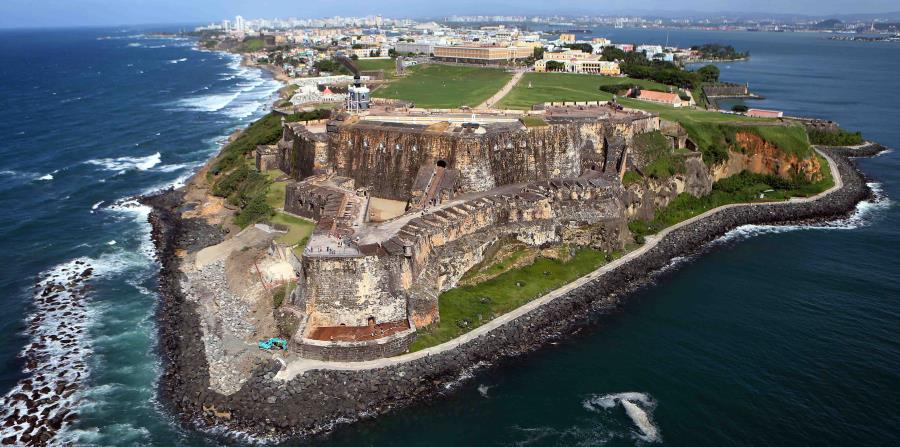 Because of its prominence in the Caribbean, a network of fortifications was built to protect the transports of gold and silver from the New World to Europe. Because of the rich cargoes, San Juan became a target of the foreign powers of the time.
Because of its prominence in the Caribbean, a network of fortifications was built to protect the transports of gold and silver from the New World to Europe. Because of the rich cargoes, San Juan became a target of the foreign powers of the time.
The British attack in 1797, during the French Revolutionary Wars, led by Sir Ralph Abercromby (who had just conquered Trinidad). His army laid siege to the city but was forced to withdraw in defeat as the Puerto Rican defenses proved more resilient than those of Trinidad. Various events and circumstances, including liberalized commerce with Spain, the opening of the island to immigrants as a direct result of the Royal Decree of Graces of 1815, and the colonial revolutions, led to an expansion of San Juan and other Puerto Rican settlements in the late 18th and early 19th century.
On May 8, 1898, United States Navy ships, among them the USS Detroit, USS Indiana, USS New York, USS Amphitrite, USS Terror and USS Montgomery, commanded by Rear Admiral William T.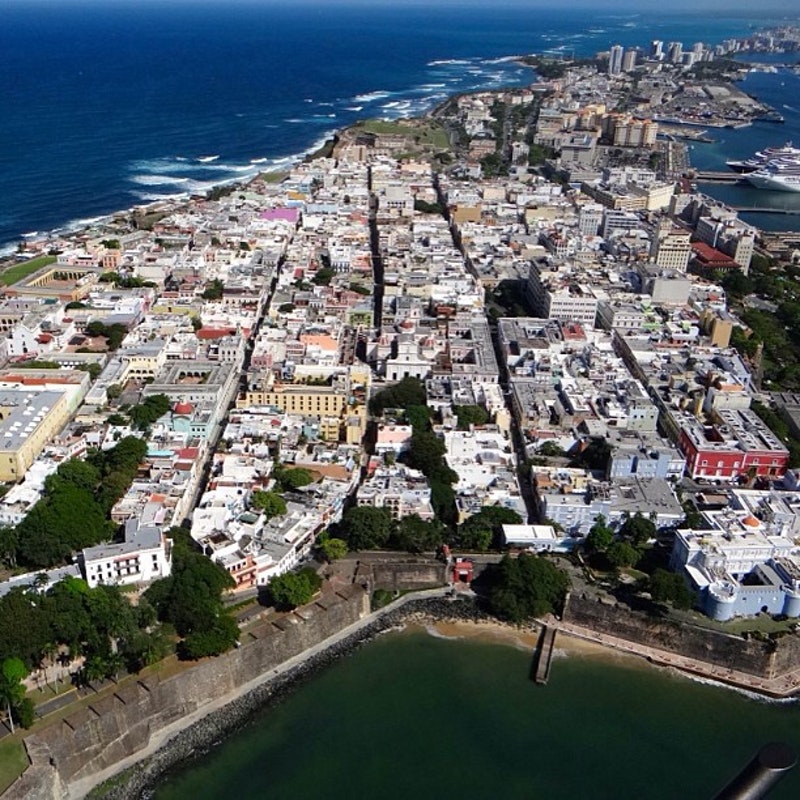 Sampson arrived at San Juan Bay. On July 25, General Nelson A. Miles landed at Guánica (in southwestern Puerto Rico) with 3,300 soldiers in what was known as the Puerto Rican Campaign. The American troops found some resistance and engaged the Spanish and Puerto Rican troops in battle, the most notable of these the battles of Yauco and Asomante. All military actions in Puerto Rico were suspended August 13, 1898, after President William McKinley and French Ambassador Jules Cambon, acting on behalf of the Spanish government, signed an armistice. Spain ceded the island to the United States later the same year by signing the Treaty of Paris.
Sampson arrived at San Juan Bay. On July 25, General Nelson A. Miles landed at Guánica (in southwestern Puerto Rico) with 3,300 soldiers in what was known as the Puerto Rican Campaign. The American troops found some resistance and engaged the Spanish and Puerto Rican troops in battle, the most notable of these the battles of Yauco and Asomante. All military actions in Puerto Rico were suspended August 13, 1898, after President William McKinley and French Ambassador Jules Cambon, acting on behalf of the Spanish government, signed an armistice. Spain ceded the island to the United States later the same year by signing the Treaty of Paris.
In 1919, Félix Rigau Carrera, “El Aguila de Sabana Grande” (The Eagle from Sabana Grande), the first Puerto Rican pilot, became the first native Puerto Rican to fly an aircraft in the island when he flew his Curtiss JN-4 from Las Casas.
On January 2, 1947, the people of San Juan elected Felisa Rincón de Gautier (also known as Doña Fela) (1897–1994) as their mayor. Thus, she became the first woman to be elected as the mayor of a capital city in any of The Americas. During the Cold War era, she served as mayor until January 2, 1969.
Thus, she became the first woman to be elected as the mayor of a capital city in any of The Americas. During the Cold War era, she served as mayor until January 2, 1969.
On October 30, 1950, San Juan was the scene of the San Juan Uprising, one of many uprisings which occurred in various towns and cities in Puerto Rico, by the Puerto Rican Nationalist Party against the Governments of Puerto Rico and the United States. Among the uprising’s main objective was to attack “La Fortaleza” (the Governors mansion) and the United States Federal Court House Building in Old San Juan. In accordance to the planned uprising in San Juan, a group of nationalists were supposed to attack simultaneously the gubernatorial mansion La Fortaleza, where Puerto Rican governor Luis Muñoz Marín resided, and the United States Federal Court House which is located close to an area called “La Marina” in Old San Juan. The La Fortaleza battle, which ensued between the nationalists and the police lasted 15 minutes, and ended when four of the five attackers were killed.
Geography
San Juan from space
San Juan is located along the north-eastern coast of Puerto Rico. It lies south of the Atlantic Ocean; north of Caguas and Trujillo Alto; east of and Guaynabo; and west of Carolina. The city occupies an area of 76.93 square miles (199.2 km2), of which, 29.11 square miles (75.4 km2) (37.83%) is water. San Juan’s main water bodies are San Juan Bay and two natural lagoons, the Condado and San José.
Climate
San Juan has a tropical climate and enjoys an average temperature of 81.0 °F (27.2 °C) . In the winter, temperatures can drop to around 60 °F (16 °C), though the average winter low is 71 °F (22 °C). Rainfall is well-distributed throughout the year, but the months of January, February, and March are the driest; Rainfall averages 56.35 inches (1,431.3 mm), falling on an average 198.5 days per year; despite this dampness, the city averages 2,970 hours of sunshine per year, or just over ⅔ of the possible total. Annual rainfall has historically ranged from 35.53 in (902 mm) in 1991 to 89.50 in (2,273 mm) in 2010.
Annual rainfall has historically ranged from 35.53 in (902 mm) in 1991 to 89.50 in (2,273 mm) in 2010.
General view of harbor at San Juan, Puerto Rico looking South to San Juan Bay, 1927.
The clock tower building at center was the San Juan Rail Terminal.
Architecture
Some of Old San Juan streets are still paved with blue cobblestones from the Spanish colonial era.
The architecture of San Juan is very diverse, due to its size and all the cultural influences received during its existence. The oldest part of the city, known as Old San Juan, mostly features the influence of Spanish architecture. This part of the city is comprised by a network of setted roads usually surrounded by ancient, two-storied houses built on masonry. Some colonial structures have been restored and serve either as government offices or museums. Some examples are the Ballajá Barracks, which now serve as museum and headquarter of several cultural organizations; La Fortaleza, which has served as the residence of the Governor of Puerto Rico since the 16th Century; and the Ancient Welfare Asylum, which now houses the Institute of Puerto Rican Culture, among others. Old San Juan also features several public squares, like the Plaza de Armas, located in front of San Juan City Hall; and cathedrals, like the Cathedral of San Juan Bautista. Old San Juan is also notable for being partly enclosed by massive walls and fortifications built by the Spanish government.
Old San Juan also features several public squares, like the Plaza de Armas, located in front of San Juan City Hall; and cathedrals, like the Cathedral of San Juan Bautista. Old San Juan is also notable for being partly enclosed by massive walls and fortifications built by the Spanish government.
The architecture is more varied in other districts of the city. The district of Santurce features a lot of influence from art deco, while the districts of Hato Rey feature more modern structures.
The main central part of the city is characterized by narrow streets made of blue cobblestone and picturesque colonial buildings, some of which date back to the 16th and 17th century. Sections of the old city are surrounded by massive walls and several defensive structures and notable forts. These include the 16th-century Fort San Felipe del Morro and the 17th-century Fort San Cristóbal, both part of San Juan National Historic Site, and the 16th-century El Palacio de Santa Catalina, also known as La Fortaleza, which serves as the governor’s mansion.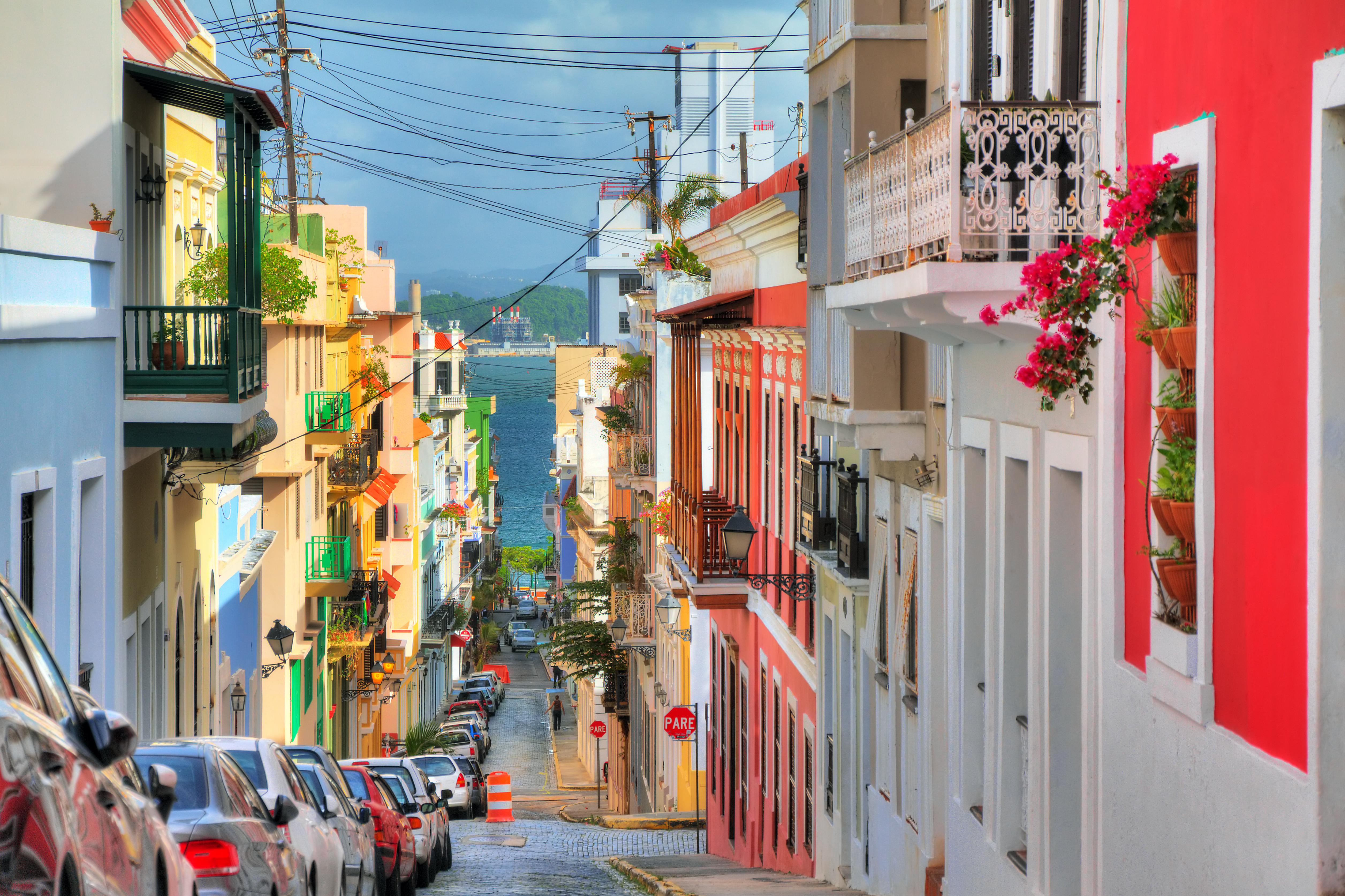 Other buildings of interest predating the 20th century are the Ayuntamiento or Alcaldía (City Hall), the Diputación Provincial and the Real Intendencia buildings, which currently house the Puerto Rico Department of State, the Casa Rosa, the San José Church (1523) and the adjacent Hotel El Convento, the former house of the Ponce de León family known as Casa Blanca, the Teatro Tapia, the former Spanish barracks (now Museum of Ballajá), La Princesa (former municipal jail, now headquartering the Puerto Rico Tourism Company), and the Santa María Magdalena de Pazzis Cemetery, located just outside the city walls. The Cathedral of San Juan Bautista (construction began in the 1520s) is also located in Old San Juan, and contains the tomb of the Spanish explorer and settlement founder Juan Ponce de León. Old San Juan, also known as the “old city”, is the main cultural tourist attraction in Puerto Rico; its bayside is lined by dock slips for large cruise ships.
Other buildings of interest predating the 20th century are the Ayuntamiento or Alcaldía (City Hall), the Diputación Provincial and the Real Intendencia buildings, which currently house the Puerto Rico Department of State, the Casa Rosa, the San José Church (1523) and the adjacent Hotel El Convento, the former house of the Ponce de León family known as Casa Blanca, the Teatro Tapia, the former Spanish barracks (now Museum of Ballajá), La Princesa (former municipal jail, now headquartering the Puerto Rico Tourism Company), and the Santa María Magdalena de Pazzis Cemetery, located just outside the city walls. The Cathedral of San Juan Bautista (construction began in the 1520s) is also located in Old San Juan, and contains the tomb of the Spanish explorer and settlement founder Juan Ponce de León. Old San Juan, also known as the “old city”, is the main cultural tourist attraction in Puerto Rico; its bayside is lined by dock slips for large cruise ships.
Tourism
San Juan Beach
Technological advances after World War II in the development of the airline industry, coupled with the island’s climate and natural setting, have transformed San Juan into the springboard for tourism around the island, and has made the rest of the Caribbean known throughout the world during the last fifty years.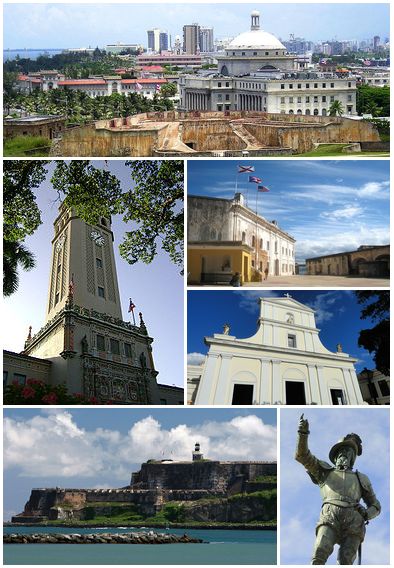 Today the capital features hotels, museums, historical buildings, restaurants, beaches and shopping centers. In San Juan there are tourist attractions, including: Old San Juan, Ocean Park, Isla Verde and Condado.
Today the capital features hotels, museums, historical buildings, restaurants, beaches and shopping centers. In San Juan there are tourist attractions, including: Old San Juan, Ocean Park, Isla Verde and Condado.
Transportation
The Port of San Juan is the fourth busiest seaport in the Western Hemisphere, ranked among the top 17 in the world in terms of container movement. It is also the largest home-based cruise port in the world with over a dozen cruise ships. It is the second busiest port in cruise volume after Miami.
The Metropolitan Area is served by two airports. The Luis Muñoz Marín International Airport, San Juan’s primary commercial airport, is located eight miles (12.9 km) from Old San Juan in the neighboring municipality of Carolina. The airport accommodates more than 30 domestic and international airlines and is the busiest airport in the Caribbean. It is often referred to as “The Gateway to the Caribbean” because it serves as the main connection to the island and the rest of the Caribbean for the United States and vice versa.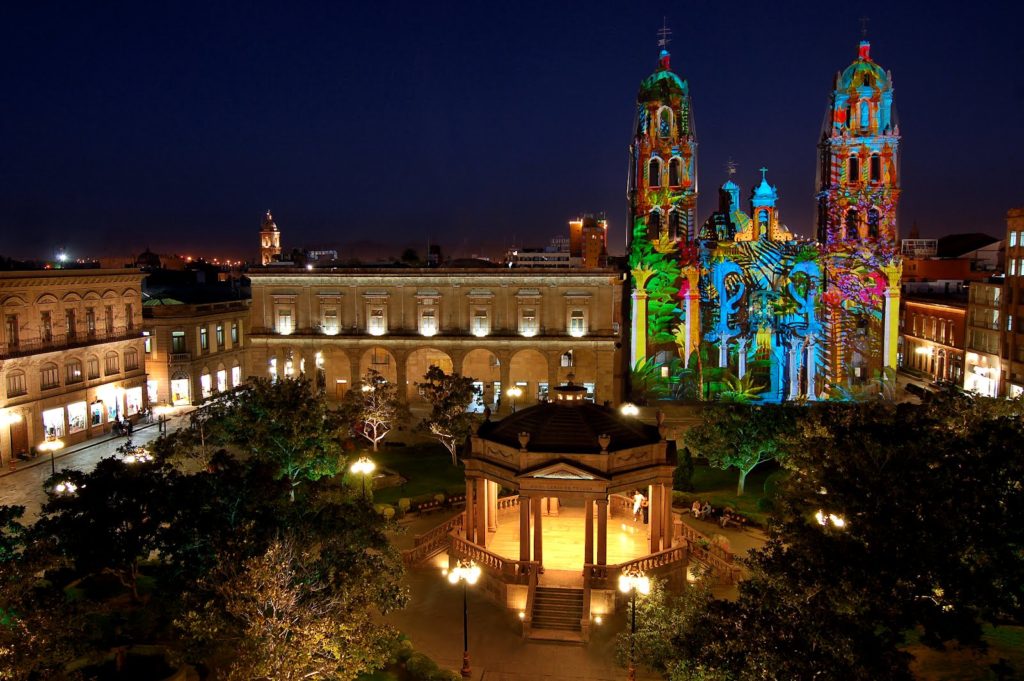 The area’s secondary airport is the Fernando Ribas Dominicci Airport, which is located directly across the San Antonio Creek or Cano San Antonio from Old San Juan in the Isla Grande district. Dominicci Airport is used mainly by general aviation aircraft, charter flights, and some domestic commercial flights.Air Sunshine is located in terminal A next to Jetblue at the Luis Munoz Marin (LMM) International airport and offers service to and from San Juan (SJU) , Anguilla(AXA),Dominica(DOM),Nevis(NEV),St.Thomas(STT),ST.Maarten(SXM),Tortola(EIS),Virgin Gorda(VIJ) and Vieques(VQS) on a regular basis and the destination of your choice on demand.
The area’s secondary airport is the Fernando Ribas Dominicci Airport, which is located directly across the San Antonio Creek or Cano San Antonio from Old San Juan in the Isla Grande district. Dominicci Airport is used mainly by general aviation aircraft, charter flights, and some domestic commercial flights.Air Sunshine is located in terminal A next to Jetblue at the Luis Munoz Marin (LMM) International airport and offers service to and from San Juan (SJU) , Anguilla(AXA),Dominica(DOM),Nevis(NEV),St.Thomas(STT),ST.Maarten(SXM),Tortola(EIS),Virgin Gorda(VIJ) and Vieques(VQS) on a regular basis and the destination of your choice on demand.
City of San Juan
San Juan – is the largest city, capital, main port and commercial center of Puerto Rico. From the port of San Juan, mainly sugar cane, fruits, coffee and tobacco are exported to the United States. The population of the city is about 437 thousand people and it is constantly growing.
From the port of San Juan, mainly sugar cane, fruits, coffee and tobacco are exported to the United States. The population of the city is about 437 thousand people and it is constantly growing.
Industries include clothing, sugar processing, cement, metal goods, tobacco, and beer. In the city center, called Hato Rei, there are a large number of banks and commercial centers. Be sure to visit the old part of the city. Its narrow streets, old buildings, small cafes and old houses with balconies hanging over the streets create an unforgettable atmosphere.
Puerto Rico is a modern and developing island that has a rich heritage and fascinates tourists. It is a walled city with numerous buildings, historical sites and monuments that have been restored to preserve the cultural heritage of the island. In 1986, the UN named the area a World Heritage Site.
The look of colonial Spain can be seen everywhere: narrow, cobbled streets, romantic courtyards, charming, overhanging balconies and chalk-white churches.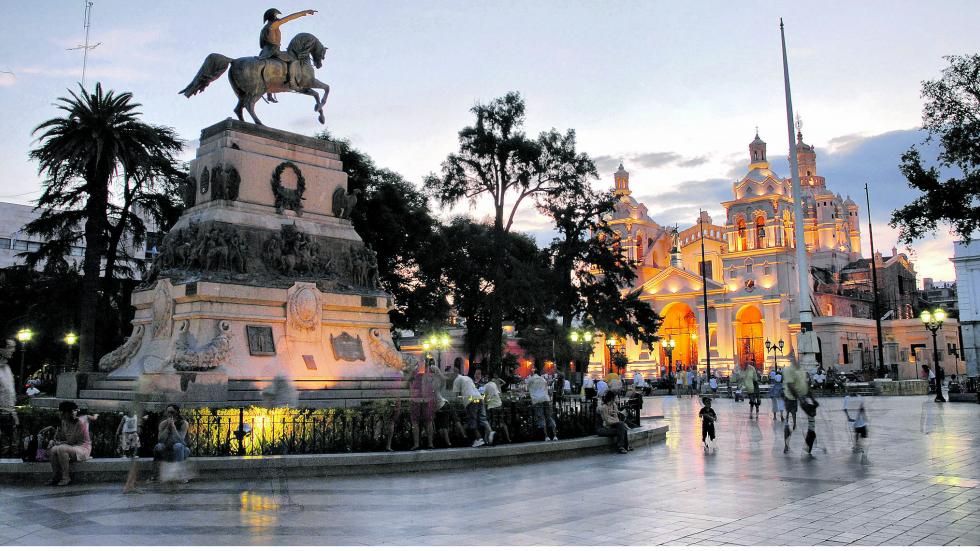 All this makes the old district of San Juan very beloved by artists and photographers around the world. A visit to San Juan is an essential part of any trip to Puerto Rico.
All this makes the old district of San Juan very beloved by artists and photographers around the world. A visit to San Juan is an essential part of any trip to Puerto Rico.
San Juan is the capital of the state of Puerto Rico and the second oldest city in all of Latin America (the oldest is the Peruvian city of Cusco). It is conveniently located in a beautiful natural harbor on the shores of the warm Caribbean Sea. Now it is a modern city with houses made of glass and concrete. San Juan is the financial and economic center of the entire region. At first glance, it even seems that the city is young.
There are no dilapidated buildings to be seen, no winding narrow alleys. The city is constantly being restored and developed, and even in its old center, at every step, you can feel the developed modern infrastructure. Take at least an abundance of small cafes and restaurants for every taste. However, after walking a little along the central streets, you involuntarily begin to feel that everything around is one huge open-air museum.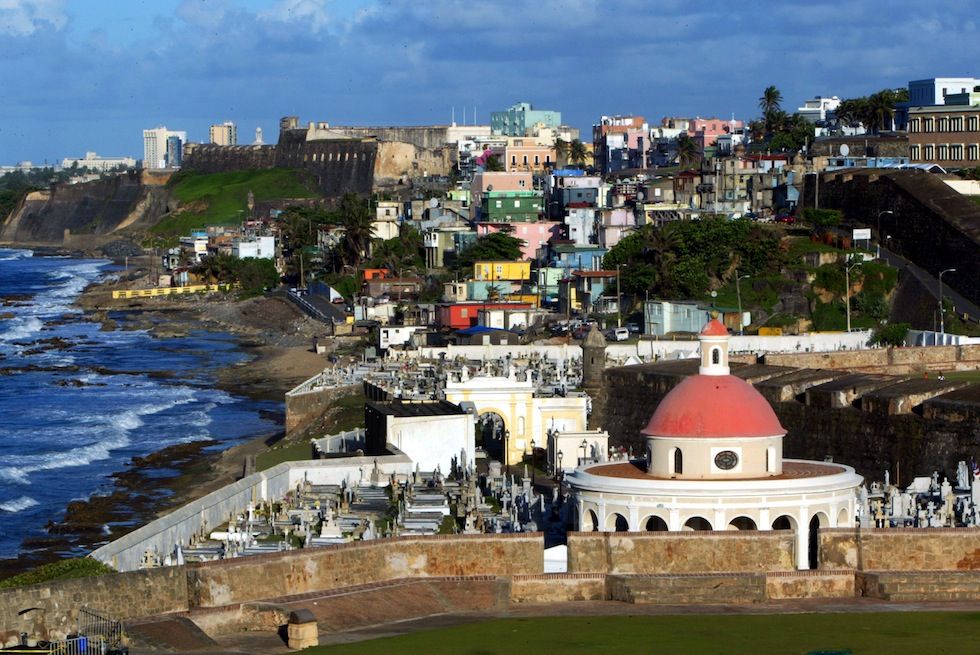 Paved with smooth paving stones (adikenes) streets. Soft pastel colors of building facades. Small balconies with wrought-iron railings that are tightly covered with flowering ivy. All this together immerses in the amazing atmosphere of the creations of the classics of Spanish literature.
Paved with smooth paving stones (adikenes) streets. Soft pastel colors of building facades. Small balconies with wrought-iron railings that are tightly covered with flowering ivy. All this together immerses in the amazing atmosphere of the creations of the classics of Spanish literature.
On the north side of Viejo San Juan there are old fortifications; earlier, together with the forts of the city, they provided protection from French, English and Dutch pirates. One of the most striking examples of Spanish fortifications of that time is the fortress of Fuerte San Philippe del’ Moro. Once she stood guard over the sea gates of the island of San Juan Bay. The fortress was considered one of the most perfect in the Caribbean. Its construction lasted for about two hundred years. Its walls, over 40 meters high, survived more than one battle. Among them, the attack of the squadron of the famous Francis Drake and the attack of the US Atlantic Squadron in 1989 year. The interior of the fortress is a labyrinth of countless rooms, some of which are carved directly into the rock of the island.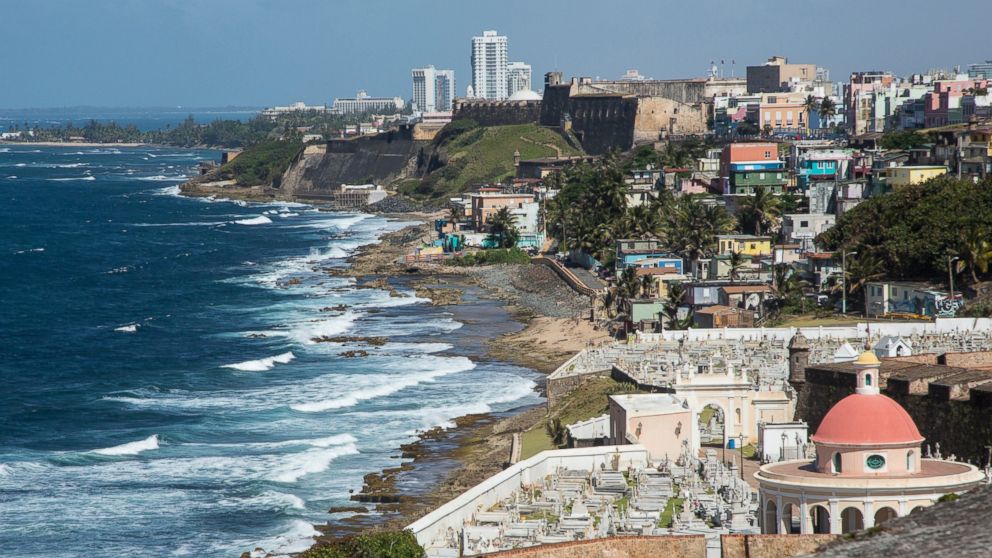
The second largest fortress – Fuerte San Cristobal – protected the island from the Northeast. It was built around the 17th century. The area of the fortress is 27 acres. This is the largest fort ever created by the Spaniards in this region.
Nowadays, tourists have a great opportunity to see all its premises, go through the labyrinth of hidden tunnels, laid right inside the walls 45 meters high. A truly fantastic panorama of the city and San Juan Bay opens from the walls of this fortress.
These two fortresses are included in the UNESCO World Heritage List and, of course, are considered a National Treasure in Puerto Rico.
In the center of the Old Town is the Plaza de San Jose, which has the shape of a regular square. The square is decorated with a statue of the founder of the city of San Jose – Juan Ponce d’Leone. On this square you can find many cozy cafes and interesting museums. Near the square is the first in Puerto Rico and one of the oldest churches in the New World – Iglesia San José. The cathedral was built in the Gothic style, which is a rarity for these places. Initially, it was built as a Dominican monastery with a chapel of Thomas Aquinas.
The cathedral was built in the Gothic style, which is a rarity for these places. Initially, it was built as a Dominican monastery with a chapel of Thomas Aquinas.
Of the other interesting sights of the island, it is worth mentioning Casa Blanca and La Fortelesa (the oldest governor’s residence in the Western Hemisphere). Tourists will also be interested in such monuments of local architecture as the Municipality (Alcalda), built in the 17th century. The La Princessa building was originally conceived as a prison, and now the office of the Association of Tour Operators of Puerto Rico and the local art gallery coexist in it.
You should definitely see the ruins of the La Muralla wall, which reached a thickness of 6 meters, and the city gates of La Puerta de San Juan. You can also get a lot of impressions from visiting the cemetery of Semeterio de San Juan and the city park, which, by the way, is inhabited by a huge number of pigeons. You can walk to the elegant Hotel El Convento, located in the building of a former convent, and admire the sculptural composition of La Rogative.
Eight kilometers from the city is perhaps the most famous (and the largest, besides) factory that produces rum. Who doesn’t know Bacardi rum? At this plant, you can observe the whole complex process of its creation, visit the museum and, of course, taste and purchase any of its many varieties.
Link to source: http://www.p-rico.ru/cities/23.php
Not Found (#404)
Not Found (#404)
Whoops…something went wrong!
Sorry, we did not find the page you are looking for
Tours
Hotels
Railway tickets
Route
Countries and cities
Location
Date there
date back
Location
Cities
Yachting
Expeditions
Dog sled tours
Snowmobile Tours
Quad bike tours
Walking tours
Alloys
Bike tours
Climbing
Ski tours
Diving and snorkeling
Jeep tours
Surfing and SUP tours
Combined tours
Horse tours
Cruises
Excursion tours
Ski trips
Helicopter tours
Fishing tours
Fitness and yoga tours
Canyoning
Railway tours
Are you looking for one of the sections below?
Tours
Hotels
Railway Tickets
Routes
Attractions
We have made a selection of interesting articles for you!
Leave a review
12345
Thank you very much 🙂
Your feedback is very important to us and will be posted on the service as soon as possible.
 The Spanish fortifications in San Juan are the oldest European construction in territory of the United States and one of the oldest in the Americas. The forts and city walls are fine examples of historic military architecture that reflect the power of the early Spanish Empire and the spread of European culture. The massive fortifications are part of the San Juan National Historic Site, which is administered by the National Park Service and featured separately in this itinerary. Castillo de San Felipe del Morro, Castillo de San Cristóbal, its circuit of defensive walls, and La Fortaleza also known as Palacio de Santa Catalina, are on the UNESCO World Heritage List.
The Spanish fortifications in San Juan are the oldest European construction in territory of the United States and one of the oldest in the Americas. The forts and city walls are fine examples of historic military architecture that reflect the power of the early Spanish Empire and the spread of European culture. The massive fortifications are part of the San Juan National Historic Site, which is administered by the National Park Service and featured separately in this itinerary. Castillo de San Felipe del Morro, Castillo de San Cristóbal, its circuit of defensive walls, and La Fortaleza also known as Palacio de Santa Catalina, are on the UNESCO World Heritage List.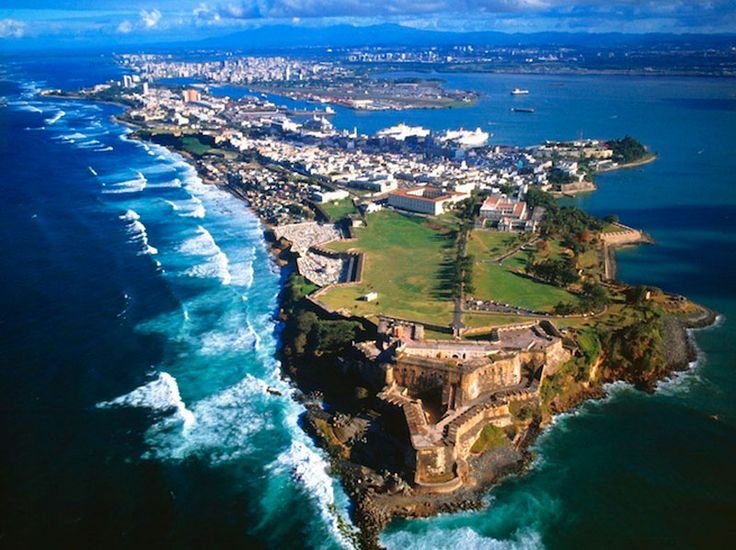 This new town replaced the settlement he had established in 1508 at Caparra, Puerto Rico, which was near the gold mines that made Puerto Rico valuable to the Spanish. Spanish ships stopped at San Juan on their journey between Spain and Hispaniola, but the colony struggled as gold became scarce. During this early period, the settlers built a number of significant buildings that still survive in Old San Juan.
This new town replaced the settlement he had established in 1508 at Caparra, Puerto Rico, which was near the gold mines that made Puerto Rico valuable to the Spanish. Spanish ships stopped at San Juan on their journey between Spain and Hispaniola, but the colony struggled as gold became scarce. During this early period, the settlers built a number of significant buildings that still survive in Old San Juan. 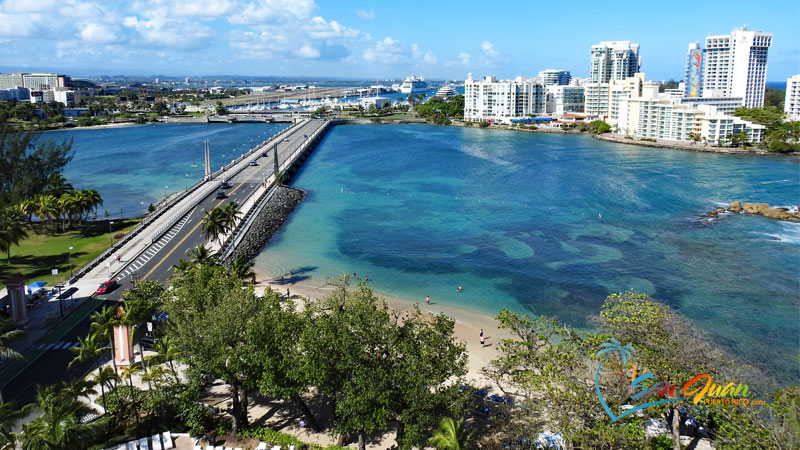 Started in 1542 and altered over the centuries, the historic cathedral is another example of Gothic and Renaissance Revival architecture.
Started in 1542 and altered over the centuries, the historic cathedral is another example of Gothic and Renaissance Revival architecture. Sometime during the 18th century, residents nicknamed Casa-Torre the Casa Blanca, or White House, which referred to the thick coat of stucco that covered both the interior and exterior walls. Stuccoing was a common practice used to protect the delicate masonry limestone walls of many buildings. Today, the house is a museum where visitors can learn about the Ponce de León family and early colonial life. The museum is at 1 Calle de San Sebastian.
Sometime during the 18th century, residents nicknamed Casa-Torre the Casa Blanca, or White House, which referred to the thick coat of stucco that covered both the interior and exterior walls. Stuccoing was a common practice used to protect the delicate masonry limestone walls of many buildings. Today, the house is a museum where visitors can learn about the Ponce de León family and early colonial life. The museum is at 1 Calle de San Sebastian. Today, visitors can explore Castillo de San Felipe del Morro and Castillo de San Cristóbal and enjoy the beautiful vistas from San Juan National Historic Site. The entrance is at 501 Calle de Norzagaray.
Today, visitors can explore Castillo de San Felipe del Morro and Castillo de San Cristóbal and enjoy the beautiful vistas from San Juan National Historic Site. The entrance is at 501 Calle de Norzagaray. Palacio Episcopal (corner of Calle del Santo Cristo de la Salud and Calle de San Sebastian) dates from 1733. Its main entrance has an elegant portal on Calle del Cristo de la Salud. Owned by the Catholic Church, the building is still used today as it was when it was built, as the Bishop of San Juan’s private residence. Constructed in 1792, the Palacio Rojo, or Red Palace, is also known as the Sala de Armas del Palacio de Santa Catalina. The two-story building housed auxiliary services for the defense of the city and served as living quarters for the Spanish post commanding officers.
Palacio Episcopal (corner of Calle del Santo Cristo de la Salud and Calle de San Sebastian) dates from 1733. Its main entrance has an elegant portal on Calle del Cristo de la Salud. Owned by the Catholic Church, the building is still used today as it was when it was built, as the Bishop of San Juan’s private residence. Constructed in 1792, the Palacio Rojo, or Red Palace, is also known as the Sala de Armas del Palacio de Santa Catalina. The two-story building housed auxiliary services for the defense of the city and served as living quarters for the Spanish post commanding officers. 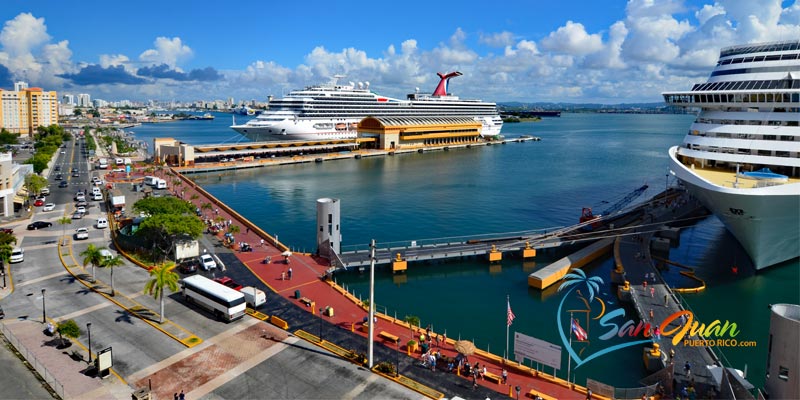 The Plaza del Mercado Municipal, the municipal market plaza on Calle de Norzagaray that now houses the Museo de Historia de la Ciudad de San Juan (Museum of the History of the City of San Juan) is another.
The Plaza del Mercado Municipal, the municipal market plaza on Calle de Norzagaray that now houses the Museo de Historia de la Ciudad de San Juan (Museum of the History of the City of San Juan) is another.
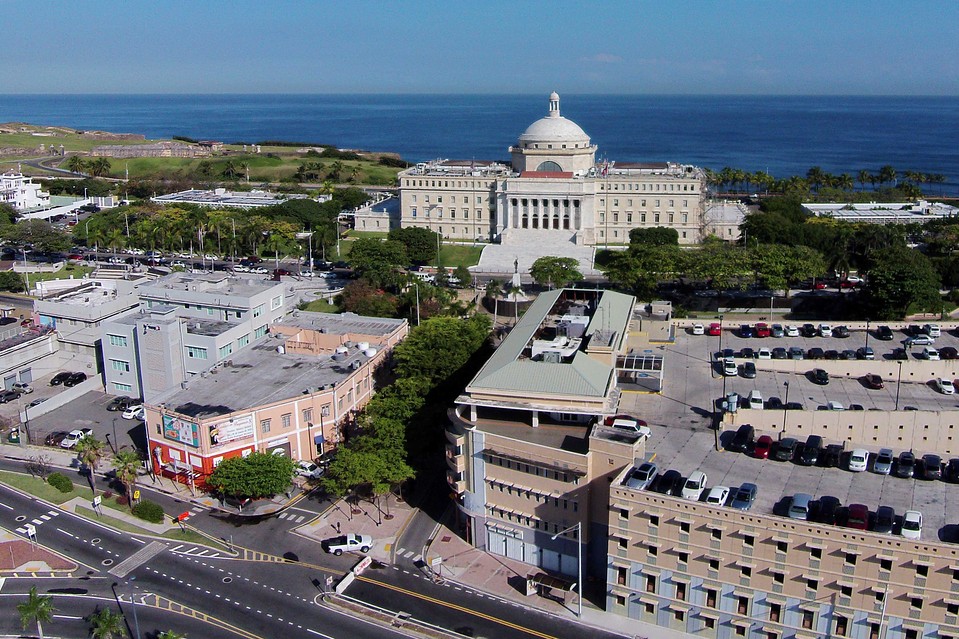 The abundance of historic buildings and sites, lively plazas, parks, promenades, gardens, museums, shops, tree-shaded cafés and restaurants make Old San Juan a fascinating destination for both local and international tourists. Visitors can hitch a ride on the free tourist trolley or stroll through downtown Old San Juan to enjoy its cobblestone streets, pastel-colored buildings, and rocky ocean-view bluffs. This itinerary can only scratch the surface of what is available to experience, learn about, and enjoy in Old San Juan. Please see the Plan Your Visit Section below and the Learn More page of this itinerary, for links to further information.
The abundance of historic buildings and sites, lively plazas, parks, promenades, gardens, museums, shops, tree-shaded cafés and restaurants make Old San Juan a fascinating destination for both local and international tourists. Visitors can hitch a ride on the free tourist trolley or stroll through downtown Old San Juan to enjoy its cobblestone streets, pastel-colored buildings, and rocky ocean-view bluffs. This itinerary can only scratch the surface of what is available to experience, learn about, and enjoy in Old San Juan. Please see the Plan Your Visit Section below and the Learn More page of this itinerary, for links to further information.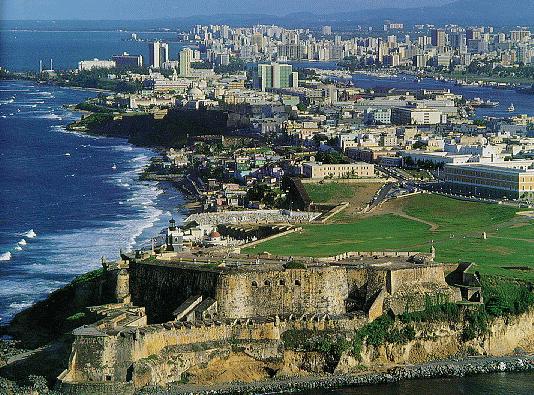 The Plaza de Armas is located on Calle de San Francisco. El Castillo de San Cristbal and Castillo San Felipe del Morro are part of the San Juan National Historic Site located at 501 Calle de Norzagaray and open daily from 9:00 a.m. to 6:00 p.m., except on Thanksgiving, Christmas Day, and New Years Day. Palacio de Santa Catalina or La Fortaleza is a National Historic Landmark located at 63 Calle de la Fortaleza. Click here for the National Historic Landmark documentation: Text and Photos. For more information on Old San Juan, visit the National Park Service San Juan National Historic Site webpage or call 787-729-6777.
The Plaza de Armas is located on Calle de San Francisco. El Castillo de San Cristbal and Castillo San Felipe del Morro are part of the San Juan National Historic Site located at 501 Calle de Norzagaray and open daily from 9:00 a.m. to 6:00 p.m., except on Thanksgiving, Christmas Day, and New Years Day. Palacio de Santa Catalina or La Fortaleza is a National Historic Landmark located at 63 Calle de la Fortaleza. Click here for the National Historic Landmark documentation: Text and Photos. For more information on Old San Juan, visit the National Park Service San Juan National Historic Site webpage or call 787-729-6777. San Juan National Historic Site is also the subject of an online lesson plan, The Forts of Old San Juan: Guardians of the Caribbean that is available in both English and Spanish through the National Park Services Teaching with Historic Places program.
San Juan National Historic Site is also the subject of an online lesson plan, The Forts of Old San Juan: Guardians of the Caribbean that is available in both English and Spanish through the National Park Services Teaching with Historic Places program.